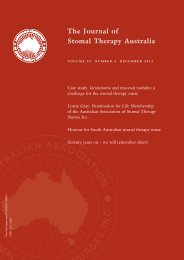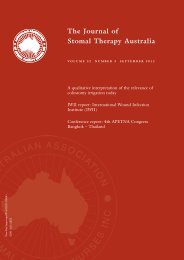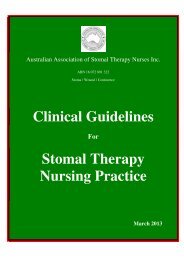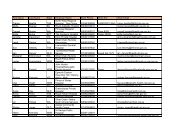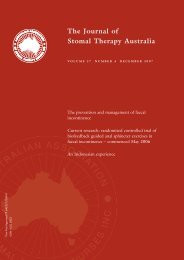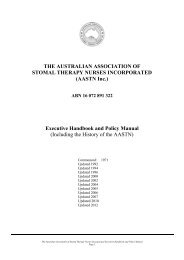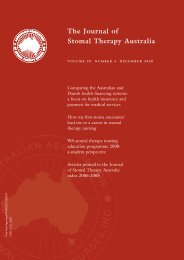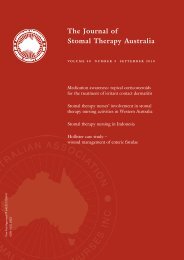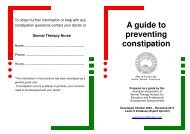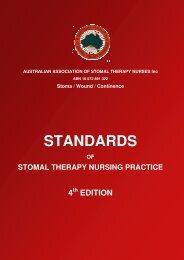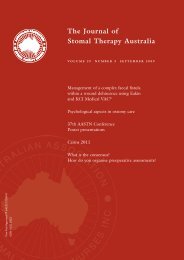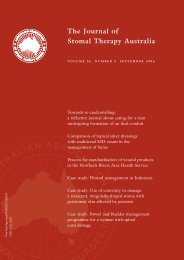The Journal of Stomal Therapy Australia - Australian Association of ...
The Journal of Stomal Therapy Australia - Australian Association of ...
The Journal of Stomal Therapy Australia - Australian Association of ...
You also want an ePaper? Increase the reach of your titles
YUMPU automatically turns print PDFs into web optimized ePapers that Google loves.
Survey research considered the rate <strong>of</strong> skin disorders in<br />
abdominal stoma patients and found that 73% reported the<br />
occurrence <strong>of</strong> a skin problem, with irritant reactions, pre-existing<br />
skin disorders, seborrhoeic dermatitis and eczema some <strong>of</strong> the<br />
most frequent skin disorders mentioned 3 .<br />
<strong>The</strong> occurrence <strong>of</strong> stoma-specific complications has been<br />
associated with a significantly higher mortality rate 5 . On the<br />
other hand, the involvement <strong>of</strong> an enterostomal nurse was<br />
associated with a six-fold decrease in stoma complications 4.<br />
Though the prevalence <strong>of</strong> stoma complications has been<br />
considered in a number <strong>of</strong> studies, albeit without great consensus<br />
as to the rate and nature <strong>of</strong> the most common complications, no<br />
published studies could be located that explore the reasons<br />
associated with the need for acute care admission among<br />
individuals living with a stoma. This gap in the literature and<br />
the higher than expected rate <strong>of</strong> acute care discharges arising<br />
from a pr<strong>of</strong>ile study <strong>of</strong> clients living with a stoma and receiving<br />
community nursing care, led to the current study.<br />
Aims and Objectives<br />
<strong>The</strong> audit study was commenced in 2005 with the aim to<br />
describe the reasons for and circumstances surrounding the<br />
discharge into acute care <strong>of</strong> community based individuals living<br />
with a stoma, who were receiving community nursing services.<br />
To enable a clinical judgment as to whether the acute readmission<br />
could have been avoided and if so how, the study had a number<br />
<strong>of</strong> stated objectives that included determining the specific<br />
reason for the discharge into acute care, identifying whether<br />
the discharge was related to the stoma, and reviewing the care<br />
delivered in the community.<br />
While confirming the appropriateness <strong>of</strong> current practice from a<br />
local perspective, the results <strong>of</strong> this audit study remain relevant<br />
to the wider ST community by <strong>of</strong>fering a description <strong>of</strong> the<br />
likely problems to arise for people living with a stoma and<br />
the likely reason for admission to hospital for clients living in<br />
the community. <strong>The</strong>se results will inform preventative care to<br />
ensure that the most common stoma problems encountered in<br />
the community are addressed by health pr<strong>of</strong>essionals in the<br />
community and acute sectors in an attempt to avoid the onset<br />
<strong>of</strong> complications.<br />
Method<br />
<strong>The</strong> ST client pr<strong>of</strong>ile study identified 63 episodes during the<br />
first six months <strong>of</strong> 2004 with an acute care discharge from the<br />
community nursing service. A retrospective client care record<br />
(CCR) audit <strong>of</strong> these stoma clients was conducted. A customised<br />
audit instrument was developed for the audit study. Members<br />
<strong>of</strong> the ST CLG each contributed to the study by conducting a<br />
proportion <strong>of</strong> the audits. A series <strong>of</strong> workshops involving all<br />
<strong>of</strong> the auditors was conducted to optimise the inter-auditor<br />
reliability.<br />
<strong>The</strong> audit forms were data entered into SPSS 14.0. <strong>The</strong> analysis<br />
relied primarily on descriptive statistics though some nonparametric<br />
tests were employed when comparing client groups<br />
on categorical outcome measures. <strong>The</strong> CLG discussed the results<br />
and the recommendations were collaboratively agreed upon.<br />
Results<br />
An audit <strong>of</strong> 60 <strong>of</strong> the 63 episodes identified to have a discharge<br />
into acute care was completed. Three records were not located<br />
within the auditing time frame and so were excluded. <strong>The</strong><br />
results are presented as they pertain to the reason for the<br />
discharge, other stoma related problems during the episode, and<br />
staff type and involvement in ST episodes. Valid responses to the<br />
questions are reported.<br />
Approximately 33.3% <strong>of</strong> clients had a stoma as their primary<br />
diagnosis (23.7% bowel; 8.5% bladder). <strong>The</strong> remaining clients<br />
had a stoma as a secondary diagnosis, though a matter for<br />
ongoing investigation by the group was the sizable proportion<br />
<strong>of</strong> clients with a diagnosis not considered by the ST specialists<br />
to be within their scope <strong>of</strong> care; namely 30% with suprapubic<br />
catheters. Though the suprapubic catheter represents a surgical<br />
opening for the removal <strong>of</strong> body waste, this care is overseen<br />
by continence specialists within the agency. A series <strong>of</strong> nursing<br />
activity codes that have served to improve recording <strong>of</strong> stoma<br />
care interventions were in place at the time <strong>of</strong> the audit, but had<br />
not been introduced in time for their inclusion in the episodes,<br />
which were audited.<br />
Reasons for discharge<br />
<strong>The</strong> vast proportion <strong>of</strong> discharges into acute care for clients<br />
with a stoma was unplanned (81.7%). <strong>The</strong> discharge was<br />
rarely identified as being in relation to the client’s stoma or<br />
for a planned reversal and 71.7% <strong>of</strong> episodes were discharged<br />
for other medical reasons. Though small cell sizes prohibited<br />
statistical analysis <strong>of</strong> this data, the figures shown in Table 1 do<br />
suggest that a greater number <strong>of</strong> discharges relating to stoma<br />
matters were planned, compared to the proportion <strong>of</strong> planned<br />
discharges for other medical conditions.<br />
Planned Unplanned Total<br />
discharge Discharge<br />
Planned reversal % 25.0 - 5.0<br />
<strong>of</strong> stoma (n=) (3) (0) (3)<br />
Other stoma % 25.0 8.3 11.7<br />
related issue (n=) (3) (4) (7)<br />
Other surgery % 8.3 12.5 11.7<br />
related issue (n=) (1) (6) (7)<br />
Other medical % 41.7 79.2 71.7<br />
condition (n=) (5) (38) (43)<br />
TOTAL % 100.0 100.0 100.0<br />
(n=) (12) (48) (60)<br />
* Valid responses – multiple responses per episode may be<br />
recorded<br />
Table 1. Cross tabulation <strong>of</strong> the reason for discharge and whether the<br />
discharge was planned or unplanned<br />
JOURNAL OF STOMAL THERAPY AUSTRALIA 2007 27(3)



